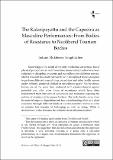Files in this item
The Kalaripayattu and the Capoeira as masculine performances : from bodies of resistance to neoliberal tourism bodies
Item metadata
| dc.contributor.author | Sen, Sanghita | |
| dc.contributor.author | Mukherjee, Indrani | |
| dc.date.accessioned | 2020-03-30T11:30:01Z | |
| dc.date.available | 2020-03-30T11:30:01Z | |
| dc.date.issued | 2017-05-31 | |
| dc.identifier | 267090666 | |
| dc.identifier | b0a40ceb-0044-41ec-ab2d-01c49b688bfc | |
| dc.identifier.citation | Sen , S & Mukherjee , I 2017 , ' The Kalaripayattu and the Capoeira as masculine performances : from bodies of resistance to neoliberal tourism bodies ' , Between , vol. 7 , no. 13 , pp. 1-22 . https://doi.org/10.13125/2039-6597/2654 | en |
| dc.identifier.issn | 2039-6597 | |
| dc.identifier.uri | https://hdl.handle.net/10023/19729 | |
| dc.description.abstract | This essay proposes to look at the emergence of two embodied martial arts from Brazil and India as tools of resistance against colonization on one hand while also comprising different kind of masculinities in postcolonial national narratives, on the other. The bodies of African slaves and Kalaripayattu martial artists became the spaces over which the contesting colonial powers met and then wrote their violent histories of dominance and power. These bodies, however, reacted violently through their disguised or secret martial moves, thus creating a counter-narrative with which to write back. Perceived as a threat, they were banned by their colonial masters; modern democratic Brazil and independent India later welcomed them back and ‘flaunted’ them to accommodate them in a deserving space of dignity within their respective national tourism industries.[1]However, today they risk being appropriated by neoliberal and global promoters of hyper-masculinity or by conservative right-wing ultra-nationalists. These people have continued to resist such moves as political and epistemological interests are increasingly challenged by the above mentioned forces. | |
| dc.format.extent | 22 | |
| dc.format.extent | 436210 | |
| dc.language.iso | eng | |
| dc.relation.ispartof | Between | en |
| dc.subject | Martial art | en |
| dc.subject | Masculinity | en |
| dc.subject | Disguise | en |
| dc.subject | Discipline | en |
| dc.subject | Decolonize | en |
| dc.subject | National narrative | en |
| dc.subject | G Geography. Anthropology. Recreation | en |
| dc.subject | T-NDAS | en |
| dc.subject.lcc | G | en |
| dc.title | The Kalaripayattu and the Capoeira as masculine performances : from bodies of resistance to neoliberal tourism bodies | en |
| dc.type | Journal article | en |
| dc.contributor.institution | University of St Andrews. Film Studies | en |
| dc.identifier.doi | 10.13125/2039-6597/2654 | |
| dc.description.status | Peer reviewed | en |
This item appears in the following Collection(s)
Items in the St Andrews Research Repository are protected by copyright, with all rights reserved, unless otherwise indicated.

